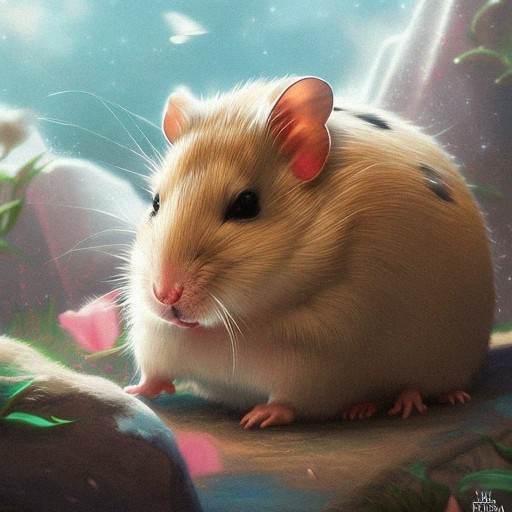Hamsters are cute little rodents that make great pets. They are known for their adorable whiskers, which give them a distinctive look. But what exactly are hamster whiskers, and why are they so important? In this article, we’ll dive into everything you need to know about hamster whiskers, from their purpose to their care.
What Are Hamster Whiskers?
Hamster whiskers, also known as vibrissae, are long, stiff hairs that grow around a hamster’s nose and mouth. They are similar to the whiskers found on cats and other animals, but hamster whiskers are much longer and more prominent. Hamsters have 12-18 whiskers on each side of their face, and they use them for a variety of purposes.
What Is the Purpose of Hamster Whiskers?
Hamster whiskers have several important functions. First and foremost, they are used for navigation. Hamsters are nocturnal animals that are active primarily at night. When they are moving around in the dark, they use their whiskers to feel their way around and detect obstacles. Hamster whiskers are incredibly sensitive, and they can detect even the slightest changes in air currents. This allows hamsters to navigate their environment with ease, even in total darkness.
In addition to navigation, hamster whiskers are also used for communication. Hamsters use their whiskers to sense the presence of other animals, including potential predators and prey. They can also use their whiskers to communicate with other hamsters. For example, when hamsters are grooming each other, they may use their whiskers to signal that they are feeling relaxed and comfortable.
Finally, hamster whiskers are also used for sensory exploration. Hamsters are curious animals that love to explore their environment. When they encounter a new object or scent, they will often use their whiskers to investigate. By brushing their whiskers against the object, they can get a sense of its texture, shape, and size.
Types of Hamster Whiskers
There are two types of hamster whiskers: primary and secondary. Primary whiskers are the longer, thicker whiskers that are located closest to a hamster’s nose. These whiskers are the most important for navigation and communication. Secondary whiskers are shorter and thinner, and they are located further back on the face. While they are less important for navigation, they still play a role in sensory exploration.
How to Care for Hamster Whiskers
Hamster whiskers are very delicate and can be easily damaged or broken. It’s important to take good care of your hamster’s whiskers to ensure that they stay healthy and intact. Here are some tips for caring for your hamster’s whiskers:
- Avoid handling your hamster’s face: Hamsters are very sensitive around their face, and they can become agitated if you try to handle their whiskers. When you need to handle your hamster, do so gently and avoid touching their face or whiskers.
- Keep the cage clean: A dirty cage can be hazardous to your hamster’s health, and it can also damage their whiskers. Make sure to clean your hamster’s cage regularly to keep it free of debris and bacteria.
- Provide plenty of bedding: Hamsters love to burrow, and providing plenty of bedding can help protect their whiskers. Make sure to provide enough bedding for your hamster to burrow and hide in.
- Avoid using wire cages: Wire cages can be dangerous for hamsters, as their whiskers can become caught in the wire. Opt for a solid-sided cage instead.
- Don’t trim your hamster’s whiskers: It may be tempting to trim your hamster’s whiskers to keep them neat and tidy, but this is not recommended. Hamster whiskers are an important sensory tool, and trimming them can cause your hamster to become disoriented and stressed. It can also put them at risk of injury, as they may not be able to navigate their environment as effectively.
- Watch for signs of damage: Hamster whiskers can become damaged or broken, especially if your hamster is living in a cage that is too small or too crowded. Watch for signs of damage, such as whiskers that are bent, broken, or missing. If you notice any damage, take steps to address the cause of the problem.
- Provide a varied diet: A healthy diet is important for all aspects of your hamster’s health, including their whiskers. Make sure to provide a varied diet that includes plenty of fresh fruits and vegetables, as well as a high-quality hamster food.
Potential Problems with Hamster Whiskers
While hamster whiskers are generally quite hardy, there are some potential problems that can arise. Here are some common issues to watch out for:
- Whisker breakage: Hamster whiskers can become damaged or broken, especially if your hamster is living in a cage that is too small or too crowded. Broken whiskers can put your hamster at risk of injury, as they may not be able to navigate their environment as effectively.
- Whisker loss: Hamster whiskers can fall out due to stress, illness, or injury. If your hamster loses a significant number of whiskers, they may have trouble navigating their environment and could become disoriented.
- Infection: In rare cases, hamsters can develop infections in their whiskers. Signs of an infection include redness, swelling, and discharge around the whiskers. If you suspect your hamster has an infection, seek veterinary care immediately.
Final Thoughts
Hamster whiskers are an important and fascinating aspect of these adorable little rodents. They are used for navigation, communication, and sensory exploration, and they require careful care to keep them healthy and intact. By following the tips and guidelines outlined in this article, you can help ensure that your hamster’s whiskers stay in top condition and that your furry friend stays happy and healthy.
